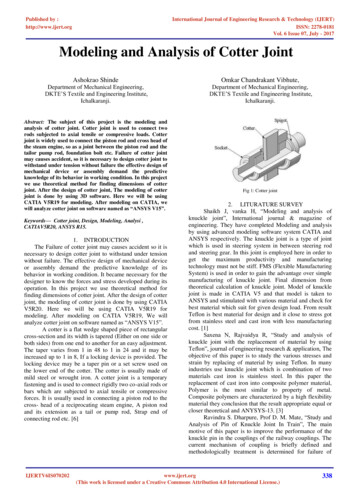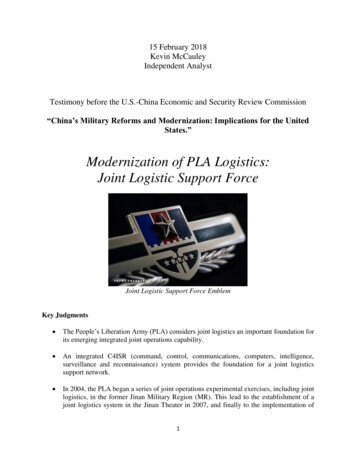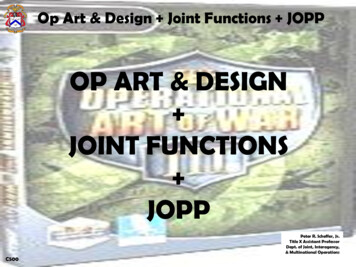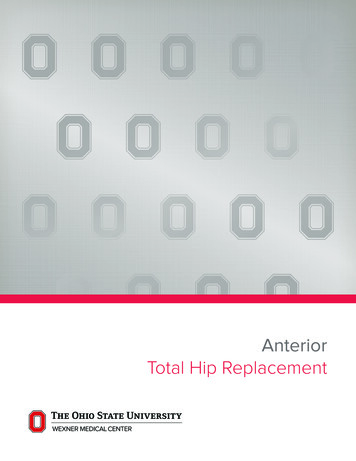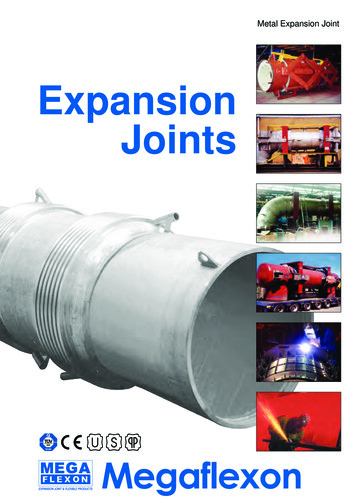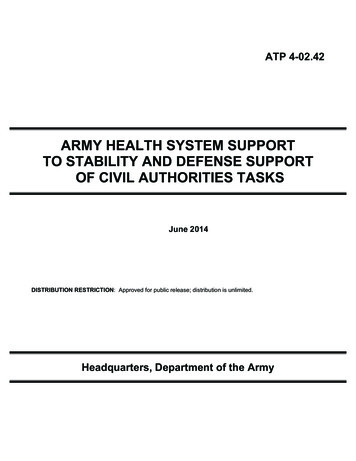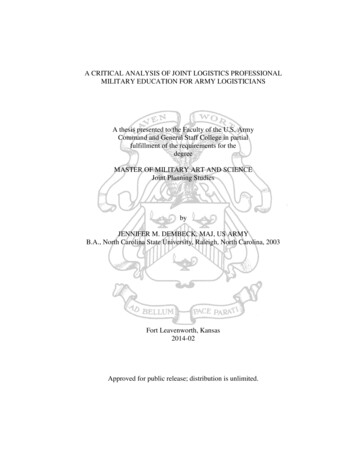
Transcription
A CRITICAL ANALYSIS OF JOINT LOGISTICS PROFESSIONALMILITARY EDUCATION FOR ARMY LOGISTICIANSA thesis presented to the Faculty of the U.S. ArmyCommand and General Staff College in partialfulfillment of the requirements for thedegreeMASTER OF MILITARY ART AND SCIENCEJoint Planning StudiesbyJENNIFER M. DEMBECK, MAJ, US ARMYB.A., North Carolina State University, Raleigh, North Carolina, 2003Fort Leavenworth, Kansas2014-02Approved for public release; distribution is unlimited.
REPORT DOCUMENTATION PAGEForm ApprovedOMB No. 0704-0188Public reporting burden for this collection of information is estimated to average 1 hour per response, including the time for reviewing instructions, searching existing datasources, gathering and maintaining the data needed, and completing and reviewing this collection of information. Send comments regarding this burden estimate or any otheraspect of this collection of information, including suggestions for reducing this burden to Department of Defense, Washington Headquarters Services, Directorate forInformation Operations and Reports (0704-0188), 1215 Jefferson Davis Highway, Suite 1204, Arlington, VA 22202-4302. Respondents should be aware that notwithstandingany other provision of law, no person shall be subject to any penalty for failing to comply with a collection of information if it does not display a currently valid OMB controlnumber. PLEASE DO NOT RETURN YOUR FORM TO THE ABOVE ADDRESS.1. REPORT DATE (DD-MM-YYYY)2. REPORT TYPE3. DATES COVERED (From - To)12-12-2014Master’s ThesisFEB 2014 – DEC 20144. TITLE AND SUBTITLE5a. CONTRACT NUMBERA Critical Analysis of Joint Logistics Professional MilitaryEducation for Army Logisticians5b. GRANT NUMBER5c. PROGRAM ELEMENT NUMBER6. AUTHOR(S)5d. PROJECT NUMBERMajor Jennifer M. Dembeck5e. TASK NUMBER5f. WORK UNIT NUMBER7. PERFORMING ORGANIZATION NAME(S) AND ADDRESS(ES)8. PERFORMING ORG REPORTNUMBERU.S. Army Command and General Staff CollegeATTN: ATZL-SWD-GDFort Leavenworth, KS 66027-23019. SPONSORING / MONITORING AGENCY NAME(S) AND ADDRESS(ES)10. SPONSOR/MONITOR’SACRONYM(S)11. SPONSOR/MONITOR’S REPORTNUMBER(S)12. DISTRIBUTION / AVAILABILITY STATEMENTApproved for Public Release; Distribution is Unlimited13. SUPPLEMENTARY NOTES14. ABSTRACTNational strategy is calling for a future defense force that is responsive, agile, flexible, and increasinglyinteroperable. As the US military prepares to meet this need in a time of fiscal constraints, it will do sowhile the organizational structure adjusts to a smaller, leaner force. Joint services, increasinglydependent upon one another, must possess a shared understanding and the ability to integratecapabilities, personnel, and systems. The Logistics Force must meet this need while operating within theprovisions of Title 10 and complex logistical authorities. Professional Military Education is the criticalcomponent to developing the foundations necessary for interoperability. This study investigates thecurrent Joint Logistics Officer Professional Military Education program at the intermediate level todetermine if it is suitable to meet DoDs current and future operational needs through a comparativeanalysis. Additionally, this study will provide a foundation for recommended improvements to jointlogistics educational opportunities that facilitate well-sustained and globally integrated operations acrossthe joint force in keeping with our National Strategic objectives.15. SUBJECT TERMSJoint Logistics Professional Military Education, Joint Logistics, Professional MilitaryEducation, JPME-116. SECURITY CLASSIFICATION OF:a. REPORTb. ABSTRACTc. THIS PAGE(U)(U)(U)17. LIMITATIONOF ABSTRACT18. NUMBEROF PAGES(U)10619a. NAME OF RESPONSIBLE PERSON19b. PHONE NUMBER (include area code)Standard Form 298 (Rev. 8-98)Prescribed by ANSI Std. Z39.18ii
MASTER OF MILITARY ART AND SCIENCETHESIS APPROVAL PAGEName of Candidate: Major Jennifer M. DembeckThesis Title: A Critical Analysis of Joint Logistics Professional Military Education forArmy LogisticiansApproved by:, Thesis Committee ChairKenneth E. Long, D.M., MemberLTC William G. Rogers, M.S., MemberMartin J. Huggard, M.S., M.M.A.S.Accepted this 12th day of December 2014 by:, Director, Graduate Degree ProgramsRobert F. Baumann, Ph.D.The opinions and conclusions expressed herein are those of the student author and do notnecessarily represent the views of the U.S. Army Command and General Staff College orany other governmental agency. (References to this study should include the foregoingstatement.)iii
ABSTRACTA CRITICAL ANALYSIS OF JOINT LOGISTICS PROFESSIONAL MILITARYEDUCATION FOR ARMY LOGISTICIANS, by Major Jennifer M. Dembeck, 106pages.National strategy is calling for a future defense force that is responsive, agile, flexible, andincreasingly interoperable. As the US military prepares to meet this need in a time of fiscalconstraints, it will do so while the organizational structure adjusts to a smaller, leaner force. Jointservices, increasingly dependent upon one another, must possess a shared understanding and theability to integrate capabilities, personnel, and systems. The Logistics Force must meet this needwhile operating within the provisions of Title 10 and complex logistical authorities. ProfessionalMilitary Education is the critical component to developing the foundations necessary forinteroperability. This study investigates the current Joint Logistics Officer Professional MilitaryEducation program at the intermediate level to determine if it is suitable to meet DoDs currentand future operational needs through a comparative analysis. Additionally, this study will providea foundation for recommended improvements to joint logistics educational opportunities thatfacilitate well-sustained and globally integrated operations across the joint force in keeping withour National Strategic objectives.iv
ACKNOWLEDGMENTSThis work would not have been possible without the assistance and support of thestaff and faculty at the US Army Command and General Staff College (CGSC) and theArmy Logistics University (ALU). The foundations for this study in Joint ProfessionalMilitary Education were developed during my time as a member of the faculty of ALUand as a student of CGSC. I am exceptionally grateful to the members of my thesiscommittee, LTC Will Rogers and Mr. Marty Huggard who provided support andguidance throughout the process. In particular, my committee chair, Dr. Ken Long,whose expertise in research and logistics was invaluable.My hope is that the critical learning areas developed in this document assist thejoint logistics force in preparing to meet the challenges of the Joint Force 2020. Further,that it has provided a foundation for the development of joint logistics professionaleducation programs tied to our national strategy. Education is the critical link in growingexperts within the field of logistics and I hope that this small study contributes to thecontinued development of joint logistics education.Finally, this project would not have been possible without the support of myhusband, Michael, and my family. Their constant encouragement was my source ofstrength and allowed me to persevere to the completion of this study. For that, I ameternally grateful.v
TABLE OF CONTENTSPageMASTER OF MILITARY ART AND SCIENCE THESIS APPROVAL PAGE . iiiABSTRACT. ivACKNOWLEDGMENTS .vTABLE OF CONTENTS . viACRONYMS . viiiILLUSTRATIONS . ixCHAPTER 1 INTRODUCTION .1Primary Research Question . 3Secondary Research Questions . 3Assumptions. 4Definition of Terms . 5Scope . 9Limitations . 10Delimitations . 10Significance of the Study . 10CHAPTER 2 LITERATURE REVIEW .12Strategic Context. 12Priorities for 21st Century Defense. 12Capstone Concept for Joint Operations . 13CJCS Vision for Joint Officer Development . 13Joint Education White Paper . 15Joint Training Guidance . 16Universal Joint Task List . 18Army Capstone Concept . 19Army Operating Concept . 20Functional Concept for Sustainment . 21Legal Foundations. 23Title 10 United States Code . 23Goldwater-Nichols Act of 1986 . 25Budget Constraints . 26Logistical Authorities . 28JPME Development . 29Officer Professional Military Education Policy . 30vi
Special Areas of Emphasis. 34J7—MECC . 35TRADOC . 36The Proponents . 43J4 Annual Guidance . 43Joint Logistics Strategic Plan . 45Joint Concept for Logistics . 46The G4 . 48CASCOM—Globally Responsive Sustainment . 49Expert Analysis . 51Educational Opportunities . 56Intermediate Level PME . 56Resident Logistics Courses . 59Web-Based Joint Education . 61Conclusion . 63CHAPTER 3 RESEARCH METHODOLOGY .64CHAPTER 4 ANALYSIS .66Joint Logistics PME Development . 67Directed . 70Recommended . 71Strategic Trends . 71Proponent Trends . 74Expert Analysis . 75Gap Analysis . 77Miscellaneous Findings . 78CHAPTER 5 CONCLUSIONS AND RECOMMENDATIONS .81Conclusions . 81Recommendations . 84APPENDIX A DIRECTED COMPARATIVE ANALYSIS .86APPENDIX B STRATEGIC TRENDS COMPARATIVE ANALYSIS .87APPENDIX C PROPONENT TRENDS COMPARATIVE ANALYSIS .89APPENDIX D EXPERT ANALYSIS TRENDS COMPARATIVE ANALYSIS .91BIBLIOGRAPHY .93vii
ACRONYMSAOCAdvanced Operations CourseCASCOMCombined Arms Support CommandCGSCCommand and General Staff CollegeCGSOCCommand and General Staff Officers CourseCJCSChairman of the Joint Chiefs of StaffCOCOMCombatant CommandDoDDepartment of DefenseELOEnabling Learning ObjectiveGNAGoldwater-Nichols Defense Reorganization Act of 1986JF2020Joint Force 2020JLEJoint Logistics EnvironmentJLEntJoint Logistics EnterpriseJLPMEJoint Logistics Professional Military EducationJPMEJoint Professional Military EducationMECCMilitary Education Coordination CouncilOCSOperational Contract SupportOPMEPOfficer Professional Military Education PolicyPMEProfessional Military EducationSAESpecial Areas of EmphasisSecDefSecretary of DefenseTLOTerminal Learning ObjectiveUSCUnited States Codeviii
ILLUSTRATIONSPageFigure 1. Officer Professional Military Education Continuum .31Figure 2. Accountable Instruction System .38Figure 3. Hierarchy of Educational Outcomes, Objectives, and Standards .39Figure 4. Cognitive Domain (Mental Skills–Knowledge) .41Figure 5. Affective Domain (Growth in Feelings or Emotional Areas–Attitude).42Figure 6. DLRO Logistics Skill Map–Advanced Application Program .59Figure 7. JPME Development .67Figure 8. JPME Development .69Figure 9. SAE 5–Comparative Analysis .71Figure 10. Strategic Trends–Comparative Analysis.72Figure 11. Proponent Trends–Comparative Analysis .74Figure 12. Expert Analysis Trends–Comparative Analysis .76ix
CHAPTER 1INTRODUCTIONThe logistic capacity of the U.S. military is unmatched, and the Nation’sability to project military power provides the joint warfighter unprecedentedcapabilities. However, a constantly changing operating environment andbudgetary constraints demand that we optimize joint logistics to enhancecapabilities. We are at a point where we have the opportunity to advance efforts todesign and implement systems, processes, and organizational changes that willimprove the support of tomorrow’s joint warfighter. 1― Lieutenant General C.V. Christianson, Joint Force QuaterlyToday’s global security environment is complex and uncertain. The ability of ournation’s military to respond rapidly and effectively to a range of military operations iscritical to achieving national strategic objectives. As the Department of Defense (DoD)prepares to meet the challenges of 21st Century warfare, our national strategy demandswe conduct globally integrated operations. The ability of the joint force to conduct abroad range of military operations is directly enabled by efficient and effective logistics.As stated most recently by the Chairman of the Joint Chiefs of Staff (CJCS) in theCapstone Concept for Joint Operations, “The strength of our Joint Force has always beenits ability to combine unique Service capabilities to project decisive military force.” 2Rationalization, standardization, and interoperability in the joint environment promoteinterdependence and provide a unique flexibility for combatant commanders in theiremployment of forces.1Lieutenant General C. V.Christianson, “Joint Logistics in the Future,” JointForce Quaterly no. 41 (2nd Quarter 2006) (accessed May 15, 2014),www.ndupress.ndu.edu.2Chairman of the Joint Chiefs of Staff, Capstone Concept for Joint Operations:Joint Force 2020 (Washington, DC: Government Printing Office, 2012), 4.1
Recent budgetary constraints 3 offer an added degree of complexity to DoDsability to conduct globally integrated operations and may pose significant challenges forour future force; however, the move toward joint interdependence may serve as a catalystfor innovative solutions and opportunities by leveraging the joint forces’ expertise andcapabilities.[W]e are in an era of austerity where budget cuts and economic uncertainties willimpose serious challenges on how we allocate resources. Our ability to define andinculcate our value proposition across the Joint enterprise will be critical inachieving the proper balance between competing operational and joint educationrequirements. 4To find the appropriate balance between the operational and institutional domain, theremust be an assessment of where our force stands currently. The use of joint professionalmilitary education (JPME) is an essential enabler for commanders in effectivelymanaging logistics capabilities in joint operations. “Ensuring the principles of missioncommand in play at the Service level can function together in joint operations requires acommon understanding of its varying manifestations and how they might beharmonized.” 5 A shared understanding of service capabilities, limitations, and systemswithin the Joint Force and broader Joint Logistics Enterprise (JLEnt) should provide thefoundational knowledge that is required in growing an interoperable force. Senior leadersof the future force must be grown now to meet this need. Common understanding acrossservices is dependent upon the educational opportunities represented in the JPME3Department of Defense, “Defense Budget Priorities and Choices - Fiscal Year2014,” January 2013, accessed September 24, 2014, http://www.defense.gov/pubs/.4Chairman of the Joint Chiefs of Staff, Capstone Concept for Joint Operations:Joint Force 2020.5Ibid., 8.2
framework. This study will examine current joint logistics professional military education(JLPME) within DoD at the intermediate level and analyze it for suitability in meetingour current and predicted future operational needs.This study will examine current operational needs through assessment of thenational strategic direction, proponent concepts and guidance for the logistics force, andassess the writings of experts in the field for implications they may have on educationalrequirements for a joint logistics force. The study will then review JPME developmentand offerings within the current program of instruction. I will determine whatshortcomings (if any) there are within the current JPME program and how thoseshortcomings translate (if at all) into professional military education. Much of theexisting literature on recent operations and experiences have highlighted the need forhighly coordinated and synchronized inter service logistics. The foundation to thisinteroperable logistical infrastructure is JPME.Primary Research QuestionIs the current Joint Logistics Officer Professional Military Education programsuitable for DoDs current and future operational needs?Secondary Research QuestionsThis study will investigate subordinate questions that will provide a foundationfor the determination.1. What do our current and projected future national strategies, policies, andconcepts require of the joint logistics community?3
2. How is joint professional military education developed? What is the process bywhich DoD converts operational experience into requirements that provides for JointLogistics education?3. What JPME is currently available to meet requirements?4. Is this consistent with the needs of the force? How well do current and plannedcapabilities satisfy experience-based requirements?5. What do we need that is not currently represented?6. What is currently represented but not at the appropriate level?Assumptions1. Joint Logistics will remain a critical function in JF2020 Operations.2. Future Joint Logistics operations must be conducted within the legal frameworkof Title 10 of the United States Code (USC) and in compliance with the GoldwaterNichols Act of 1986.3. The cognitive and affective levels of learning associated within the DoDprofessional military education system, having been accredited, are achieving thelearning objectives.4. The US Army Command and General Staff College (CGSC) is representativeof sister service ILE institutions and joint educational programs are equivalent.5. Budget and funding constraints will continue to impact the force across theDOTMLPF (Doctrine, Organization, Training, Materiel, Leadership, Personnel andFacilities) spectrum.4
Definition of TermsAs a part of this thesis there are several terms that must be defined to provide acontext for their use within this body of research. The criticality of a common logisticslanguage across the joint services is illustrated by the 2011 publication of the “JointLogistics Lexicon”, published by the Joint Staff, J4, Lieutenant General Kathleen Gainey.“The lack of a shared language has created or exacerbated many of the challenges toachieving the Logistics Community’s vision of integrated logistics capabilities and,ultimately, freedom of action for the joint warfighter.” 6 This publication will serve as abaseline for both currently approved logistics terms (as per JP 1-02 Department ofDefense Dictionary of Military and Associated Terms) as well as for developing logisticsterminology. The following defined terms will provide context to the study and aresignificant to the readers understanding of this research.Common User Logistics. Materiel or service support shared with or provided bytwo or more Services, Department of Defense agencies, or multinational partners toanother Service, Department of Defense agency, non-Department of Defense agency,and—or multinational partner in an operation. 7Directive Authority for Logistics. Combatant commander authority to issuedirectives to subordinate commanders to ensure the effective execution of approvedoperation plans, optimize the use or reallocation of available resources, and prevent or6Joint Chiefs of Staff, J4 Logistics, “Joint Logistics Lexicon,” March 1, 2011,accessed September 2, 2014, x.7Joint Chiefs of Staff, Joint Publication (JP) 1-02, Department of DefenseDictionary of Military and Associated Terms (Washington, DC: Government PrintingOffice, 2010 amended through August 2014).5
eliminate redundant facilities and—or overlapping functions among the Servicecomponent commands. Also called DAFL. 8Executive Agent. A term used to indicate a delegation of authority by theSecretary of Defense (SecDef) or Deputy Secretary of Defense to a subordinate to act onbehalf of the Secretary of Defense. 9Globally Integrated Operations. The concept for how the Joint Force shouldprepare for the security environment we will soon face. 10Interdependent. Not currently defined by doctrine.Interoperability. (1) The ability to operate in synergy in the execution of assignedtasks. 11 (2) The condition achieved among communications-electronics systems or itemsof communications-electronics equipment when information or services can beexchanged directly and satisfactorily between them and—or their users. The degree ofinteroperability should be defined when referring to specific cases. 12Joint. Connotes activities, operations, organizations, etc., in which elements oftwo or more Military Departments participate. 138Ibid.9Ibid.10Chairman of the Joint Chiefs of Staff, Capstone Concept for JointOperations, 4.11Joint Chiefs of Staff, JP 1-02.12Ibid.13Ibid.6
Joint Interdependence. The purposeful reliance by one Service on anotherService’s capabilities to maximize complementary and reinforcing effects of both (i.e.,synergy), the degree of interdependence varying with specific circumstances. 14Joint Logistics. The coordinated use, synchronization, and sharing of two or moreMilitary Departments’ logistic resources to support the joint force. 15Joint Logistics Enterprise. A multi-tiered matrix of key, global logistics providersexisting at the strategic, operational, and tactical levels of war. 16Joint Logistics Environment. The joint logistics environment is the sum ofconditions and circumstances that affect logistics. 17Joint Professional Military Education. The critical element in officer developmentand is the foundation of a joint learning continuum that ensures our Armed Forces areintrinsically learning organizations. The Professional Military Education (PME) visionunderstands that young officers join their particular Service, receive training andeducation in a joint context, gain experience, pursue self-development, and, over thebreadth of their careers, become the senior leaders of the joint force. Performance andpotential are the alchemy of this growth, but nothing ensures that they are properly14Joint Chiefs of Staff, Joint Publication (JP) 1, Doctrine for the Armed Forces ofthe United States (Washington, DC: Government Printing Office, 2013).15Joint Chiefs of Staff, Joint Publication (JP) 4-0, Joint Logistics (Washington,DC: Government Printing Office, 2013).16Joint Chiefs of Staff, J4 Logistics, J4 Joint Logistics Strategic Plan 2010-2014(Washington, DC: Government Printing Office, 2010).17Joint Chiefs of Staff, JP 1-02.7
prepared leaders more than the care given to the content of their training, education,experience, and self-development opportunities. 18Lead Service. A Service component or Department of Defense agency that isresponsible for execution of common-user item or service support in a specific combatantcommand (COCOM) or multinational operation as defined in the combatant orsubordinate joint force commander’s operation plan, operation order, and—ordirectives. 19Logistics. (1) Planning and executing the movement and support of forces. 20 (2)Planning and executing the movement and support of forces. It includes those aspects ofmilitary operations that deal with: design and development, acquisition, storage,movement, distribution, maintenance, evacuation, and disposition of materiel; acquisitionor construction, maintenance, operation, and disposition of facilities; and acquisition orfurnishing of services. 21Operational Environment. A composite of the conditions, circumstances, andinfluences that affect the employment of capabilities and bear on the decisions of thecommander. Also called OE. 2218Chairman of the Joint Chiefs of Staff, Officer Professional Military EducationPolicy (OPMEP), 2-3.19Joint Chiefs of Staff, JP 1-02.20Ibid.21Department of the Army, Army Doctrinal Reference Publication (ADRP) 4-0,Sustainment Operations (Washington, DC: Government Printing Office, July 2012).22Joint Chiefs of Staff, JP 1-02.8
Power Projection. The ability of a nation to apply all or some of its elements ofnational power-political, economic, informational, or military-to rapidly and effectivelydeploy and sustain forces in and from multiple dispersed locations to respond to crises, tocontribute to deterrence, and to enhance regional stability. 23Rationalization. Any action that increases the
that it has provided a foundation for the development of joint logistics professional education programs tied to our national strategy. Education is the critical link in growing experts within the field of logistics and I hope that this small study contributes to the continued development of joint logistics education.
